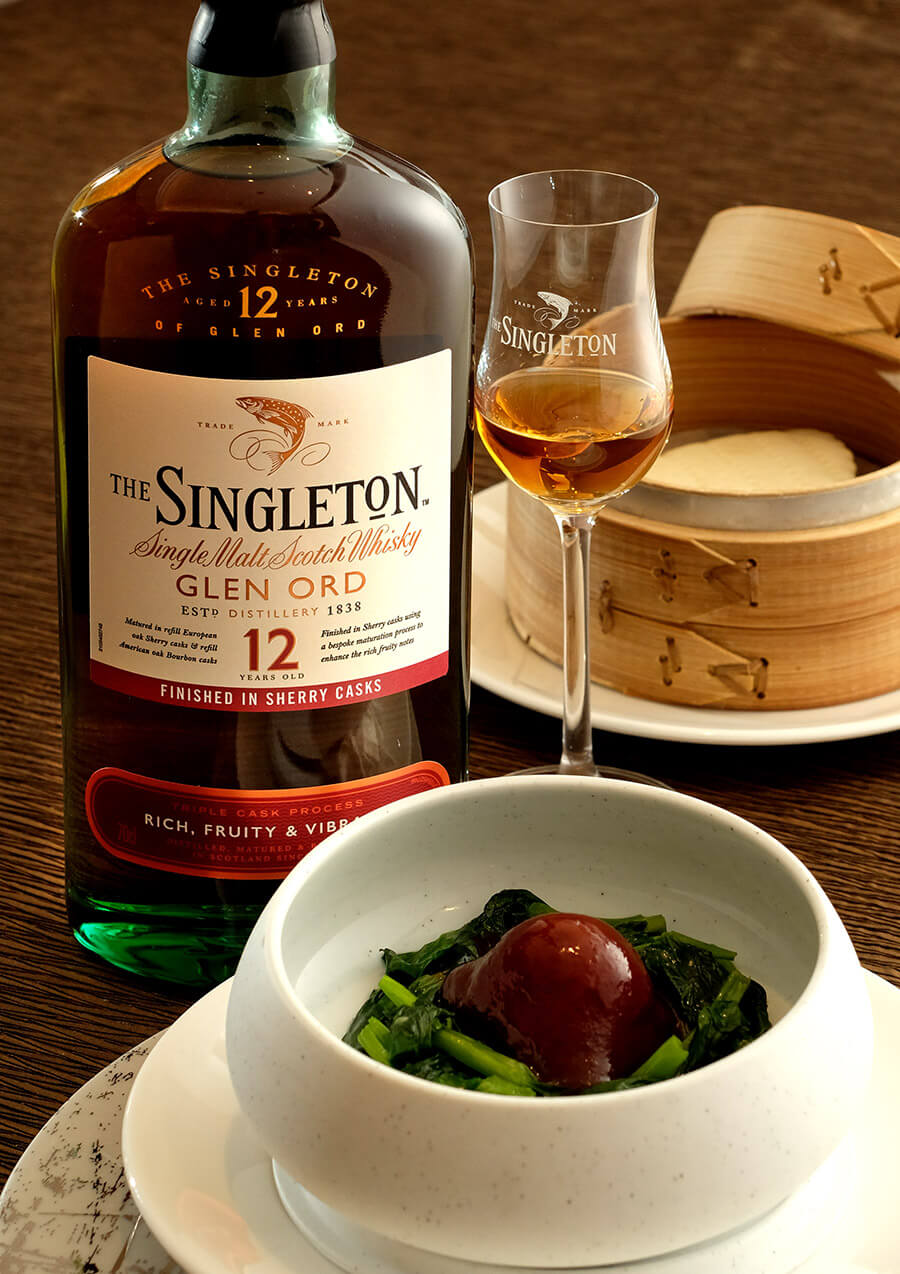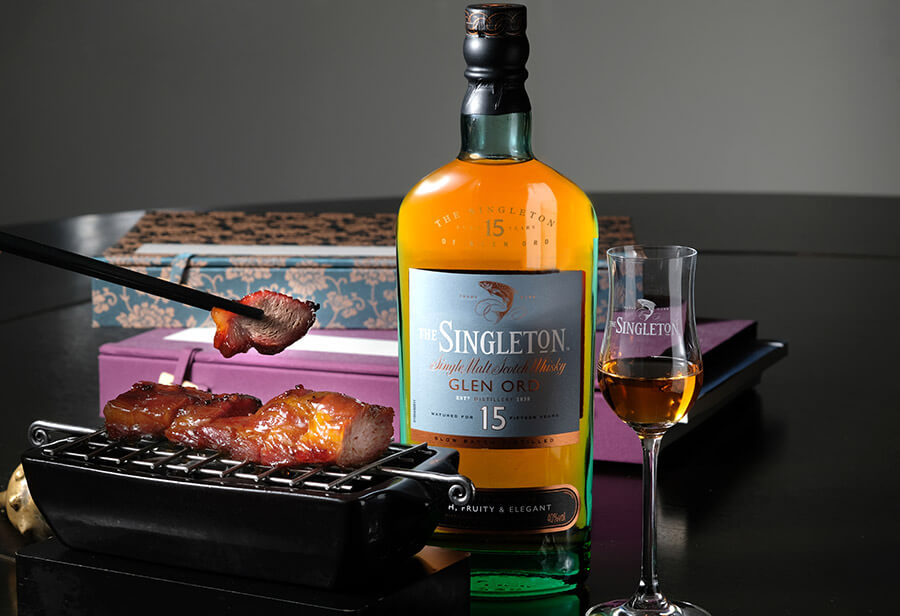Dishes ready. Everybody eats and speaks what they want to. The charisma of Chinese banquets is that you can choose what you like in tremendous dishes and enjoy the chef’s performance - how they control ingredients, seasonings and heat.
People who grew up in Chinese culture are all familiar with this dining culture. When wine became popular, it also became an alternative on dining tables, except for traditional Chinese yellow wine and distilled rice wine. Tannins and acidity in wine are definitely surprising to meet with, yet the metallic taste will easily interfere with your dining experience. If you don’t know much about wine’s flavour and the traits of dishes, using wine to pair with food will surely shock your taste buds more than impress.
Whisky has reached a new level of pairing Western wine and Chinese cuisines. In short, the disturbance of wine on Eastern dining almost disappeared. Whisky which matured in casks can get along with the umami in Chinese cuisines, even bringing mutual benefits. While the vanilla notes in wood have seeped into whisky and transformed as a fruity or honey-like sweetness, the warmth of toffee and coconut, and spice of cinnamon and ginger. They can always resonate with elements of Chinese cuisines and spark.

 Let’s take Sichuan cuisine as an example and you will understand the compatibility of whisky and Chinese cuisine. There’s a saying ‘each dish has its own style; a hundred dishes have a hundred different flavours.’ Sichuan cuisine is famous for its variations. The ‘three peppers’ (Sichuan peppercorn, pepper and chili), ‘three spices’ (spring onion, ginger and garlic), chili bean sauce and fermented soy bean intertwine and create wonderful flavours that can both stay alone and coexist with others - sometimes spicy and numbing, sometimes mellow and rich.
Let’s take Sichuan cuisine as an example and you will understand the compatibility of whisky and Chinese cuisine. There’s a saying ‘each dish has its own style; a hundred dishes have a hundred different flavours.’ Sichuan cuisine is famous for its variations. The ‘three peppers’ (Sichuan peppercorn, pepper and chili), ‘three spices’ (spring onion, ginger and garlic), chili bean sauce and fermented soy bean intertwine and create wonderful flavours that can both stay alone and coexist with others - sometimes spicy and numbing, sometimes mellow and rich.
The traditional cuisine ‘‘Sichuan Boiled Beef’ has a beautiful reddish colour and spicy aroma; the red chili oil and tremendous Sichuan peppercorns and dried chili on the surface have decorated the marbled beef ribs with an exciting mala flavour. Mala, which means numbing and spicy, is more of a burning pain than a taste. If this kind of sensation is further catalysed by alcohol, people who don’t love spicy food may feel uncomfortable. Nevertheless, adding ice or water to whisky can resonate with the spicy aroma; the sweet notes of vanilla, toffee and honey can also tone down the spiciness. ‘The Singleton of Glen Ord 15 Year Old Single Malt Scotch Whisky’, which has a balanced and free-spirited character is just a good match. This combination is also compatible with hot food such as ‘Sichuan Hot Pot’, ‘Spicy Hot Pot’, ‘Mapo Tofu’ and ‘Pork Lungs in Chili Sauce’. Even Highball is a good match too. Enjoying spicy food with cold drinks is just gratifying.
Made with Chinese spices like spring onion, crushed ginger, Sichuan peppercorns and star anise, the 'Crispy Cherry Valley Roasted Duck Confit’ is considered a revolutionised version of modern Sichuan cuisine. The thin-skinned, meaty duck leg is first marinated before steaming and deep frying. The meat inside is tender and moist while the skin is golden and crispy. The spices fairly season the duck, toning down the greasiness, without stealing too much attention. The crispy skin is just right with the mellow and balanced ‘The Singleton of Glen Ord 12 Year Old Single Malt Scotch Whisky’. Same logic applies to dishes which focus on the main ingredients and season with spices, such as ‘Sliced Pork Belly with Garlic Sauce’ and ‘Steamed Codfish with Savory Crispy Beans’.
 Known for its strong taste, Shanghai cuisine is actually composed of characters of Hangzhou, Ningbo, Huaiyang, Suzhou and Wuxi. It keeps evolving and exploring. Deep down in the strong and rich taste, you can still taste the mellowness and umami. 'Braised Pork Back Knee with Rock Sugar’ is a perfect representative of Shanghai cuisine.
Known for its strong taste, Shanghai cuisine is actually composed of characters of Hangzhou, Ningbo, Huaiyang, Suzhou and Wuxi. It keeps evolving and exploring. Deep down in the strong and rich taste, you can still taste the mellowness and umami. 'Braised Pork Back Knee with Rock Sugar’ is a perfect representative of Shanghai cuisine.
Inspired by ‘Dongpo Pork’, this dish uses the pork back knee instead of fat belly. You can enjoy the jelly-like texture of collagen without worrying about cholesterol. Braised in carefully cooked marinade on medium low heat, the back knee can have richer flavour and collagen. Seasoned by red yeast rice sauce and Shaoxing wine then wrapped by Chinese pancake, it’s a surprising and fulfilling dish, which is a perfect match with the smooth and round ‘The Singleton of Glen Ord 12 Year Old Single Malt Scotch Whisky Sherry Cask Edition’. ‘Slow distillation’ brings out a silky texture and sweet dried fruits aftertaste to tone down the thick and oily texture; the grease of the dish can also reduce the tannins from sherry. Dishes with strong flavours such as ‘Braised Sea cucumber with Pork Tendon’, ‘Braised Chestnut Chicken’ and ‘Braised Meatball’.
 Whisky can keep pace with strong flavour, so do light flavour. Using only little spices to cook, Cantonese cuisine emphasises on the original flavour of food, amplifying their inborn traits. Behind Cantonese cuisine’s umami and lightness is the pursuit of quality ingredients, excellent heat control and actual presentation of original flavour. Be it fish, vegetables or chicken, all ingredients can stay true to their flavour. It sounds reasonable but never easy to achieve.
Whisky can keep pace with strong flavour, so do light flavour. Using only little spices to cook, Cantonese cuisine emphasises on the original flavour of food, amplifying their inborn traits. Behind Cantonese cuisine’s umami and lightness is the pursuit of quality ingredients, excellent heat control and actual presentation of original flavour. Be it fish, vegetables or chicken, all ingredients can stay true to their flavour. It sounds reasonable but never easy to achieve.
The use of dried seafood is a talent. Every detail such as the way of picking, preserving and soaking all influences the quality of dried seafood. Be it expensive abalone, sea cucumber, shark fin and fish maw, or dried scallops and shrimps for seasoning, they are all resonating with the umami, mellow and pure taste of Cantonese cuisine.
‘Steamed Sliced Giant Garoupa with Spring Onion’, a dish cooked by excellent heat control and fair seasoning, can truly present the tenderness and umami of Garoupa. Its lightness is just right to pair with a smooth and aromatic ‘The Singleton of Glen Ord 12 Year Old Single Malt Scotch Whisky’. Dishes which emphasise on heat control like ‘Scallop Stir-fry’ and ‘Steamed Fish’ are also suitable.
‘Honey Roasted Barbecued Pork (Char Siu)’ is a good match with whisky too. Tender pork marinated by dark soy sauce, hoisin sauce, cinnamon, star anise, salt and rock sugar for a day. Instead of ‘sliced’, the roasted pork is ‘chopped’ as one centimetre thick, so as to keep the juice and meaty flavour when we chew. The burnt and oily aroma of the roasted pork can balance with the tannins in ‘The Singleton of Glen Ord 15 Year Old Single Malt Scotch Whisky’. Also, the luscious Char Siu sauce can emphasise whisky’s vivid aromas and enrich its layers. Salty and umami dishes like ‘Soy Braised Goose Livers’, ‘Prawns in Salted Egg Yolks’ and ‘Salted Fish with Tofu and Diced Chicken Pot’ are also nice to pair with the 15 Year Old.
While Food writer Yeh Yi-Lan personally recommends the pairing of ‘Combo Rice’ and ‘The Singleton of Glen Ord 12 Year Old Single Malt Scotch Whisky Sherry Cask Edition’. Frying jasmine rice with savoury ingredients such as roasted goose, Chinese sausages, liver sausages, dried scallops, shiitake and massive sakura shrimps, this dish is full of ‘wok hei’ and aromas. All flavours are blended yet clearly shown; rice is fluffy and full of umami. Besides, the thin, crispy texture and oily aroma of roasted duck with the salty sweet bean sauce is also compatible with the 12 Year Old Sherry Cask Edition.
 ▼▼▼
▼▼▼